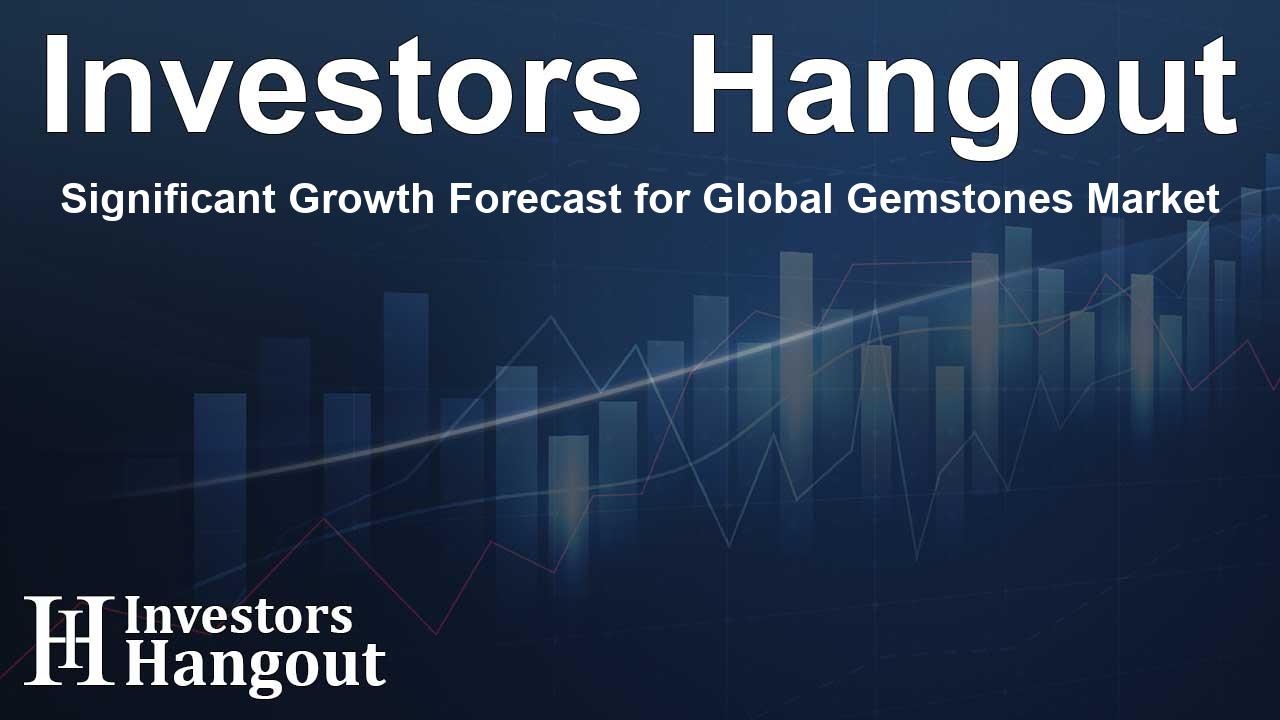Significant Growth Forecast for Global Gemstones Market

Insights into the Growing Gemstones Market
The gemstones market is witnessing a remarkable surge, fueled by changing consumer behaviors, advancements in technology, and increasing wealth in developing nations. Recent analyses reveal that the market was valued at USD 58,291.02 million in recent years and is expected to soar to USD 101.01 billion by 2032, achieving a notable compound annual growth rate (CAGR) of 6.30% over the forthcoming years.
Market Dynamics and Overview
The gemstones market comprises various precious and semi-precious stones, including diamonds, rubies, sapphires, emeralds, and other colored gemstones, predominantly utilized in jewelry, investment, and industrial capacities. In recent years, this industry has evolved significantly, with a focus on sustainability, transparency, and the rise of lab-created gemstones, reshaping market dynamics. As the market expands from USD 58,291.02 million to an anticipated USD 101,018.53 million by 2032, sustained consumer confidence and surging demand across numerous segments are becoming increasingly evident.
Regional Market Insights
As of now, North America plays a pivotal role in the global gemstones market, commanding a revenue share of 36.59% in 2024 due to robust purchasing power and the heightened preference for certified, ethically sourced gemstones. However, the Asia-Pacific region is rapidly emerging as a significant market, stimulated by urban growth, rising disposable incomes, and the cultural importance of gemstones within nations like China, India, and Japan. The market landscape is characterized by established mining companies like De Beers, PJSC ALROSA, and Rio Tinto, alongside innovative synthetic gemstone suppliers and specialized retailers making strides through technology and vertical integration.
Growth Catalysts in the Industry
One crucial factor driving the market is the increasing demand for ethical and sustainable gemstones. Environmentally and socially conscious consumers are transforming purchasing behaviors, emphasizing transparency in sourcing. This trend is particularly noticeable among younger buyers who prioritize sustainability and ethical production. Companies are adapting their practices, implementing traceability systems and seeking certifications like the Kimberley Process to affirm the ethical origins of their products.
Emergence of Lab-Grown Alternatives
The lab-grown gemstone sector is proving to be a disruptive force within the market, offering chemically identical substitutes to natural stones at more accessible price points and addressing environmental concerns linked to traditional mining. Estimates suggest that the global lab-grown diamond market, valued recently at USD 22.79 billion, may reach USD 74.45 billion by 2032, showing a staggering CAGR of 14.11% that significantly exceeds natural gemstones’ growth. Innovations in manufacturing processes have enabled the swift production of high-quality synthetic stones, attracting youthful consumers looking for authentic yet economical options.
Technological Advances and E-Commerce Influence
Digital transformation is revolutionizing how consumers purchase gemstones, providing seamless online access to certified stones along with clear pricing and in-depth product insights. E-commerce platforms are eliminating traditional barriers, allowing direct-to-consumer sales models that enhance price competitiveness. The use of social media and collaborations with influencers is reshaping how brands engage with consumers by showcasing gemstone jewelry and educating them on quality standards and trends.
Challenges in the Gemstones Supply Chain
Despite the positive outlook, the gemstones industry deals with substantial supply chain hurdles, particularly highlighted by the fragmented sourcing involved in the colored gemstone segment, where much originates from small-scale miners. Issues such as poor record-keeping and numerous intermediaries inflate prices, creating significant challenges regarding transparency. Additionally, geopolitical tensions in resource-rich areas can complicate sourcing efforts, affecting the overall availability and cost-effectiveness of gemstones.
Price Sensitivity and Market Volatility
Gemstones are often seen as luxury goods, meaning their demand is highly responsive to economic conditions and consumer confidence levels. Economic downturns can directly influence discretionary spending on jewelry, leading to revenue fluctuations. Moreover, the rapid growth of lab-created stones exerts considerable pressure on traditional gemstones’ pricing structures, threatening established market paradigms based on scarcity. As consumers become more educated about gemstones, traditional pricing models are being challenged.
Adapting to Regulatory and Certification Challenges
The gemstones market operates within increasing regulatory standards aimed at preventing unethical practices and ensuring authenticity. Compliance with certification processes can impose significant costs, affecting smaller market players disproportionately. Adhering to varied regulations across international markets complicates operations for traders, making investments in compliance a critical aspect for success in a competitive landscape.
Forward-Looking Market Trends
Emerging trends including the adoption of blockchain technology for authentication and transparency are becoming pivotal in the industry. Prominent companies are utilizing digital ledgers to enhance the integrity of gemstone sourcing, providing consumers assurance regarding the stones’ origins. Additionally, the demand for personalized jewelry pieces continues to grow, with consumers increasingly favoring custom creations that have personal significance over mass-produced designs.
Investment Potential in Gemstones
Gemstones are gaining recognition as appealing alternative investment assets, providing opportunities for portfolio diversification and a hedge against inflation, especially for unique high-quality stones. Increased enthusiasm from high-net-worth individuals and families towards investment-grade gemstones signals a noteworthy trend in how gemstones are perceived by financially savvy buyers.
Frequently Asked Questions
What is the current value of the gemstones market?
The gemstones market was valued at approximately USD 58.3 billion recently and is expected to grow to USD 101.01 billion by 2032.
What are the key segments within the gemstones market?
The market features segments such as diamonds, rubies, sapphires, emeralds, lab-grown stones, and colored gemstones.
How is consumer behavior changing in the gemstones market?
Consumers are increasingly looking for ethically sourced and sustainable gemstones, particularly younger generations who value transparency.
What role does technology play in the gemstones market?
Technology facilitates online shopping experiences, enhances certification and traceability, and streamlines production processes through innovations like AI.
Are gemstones becoming viable investment options?
Yes, gemstones are increasingly recognized as alternative investment assets, valued for their potential to appreciate and offer portfolio diversification.
About The Author
Contact Owen Jenkins privately here. Or send an email with ATTN: Owen Jenkins as the subject to contact@investorshangout.com.
About Investors Hangout
Investors Hangout is a leading online stock forum for financial discussion and learning, offering a wide range of free tools and resources. It draws in traders of all levels, who exchange market knowledge, investigate trading tactics, and keep an eye on industry developments in real time. Featuring financial articles, stock message boards, quotes, charts, company profiles, and live news updates. Through cooperative learning and a wealth of informational resources, it helps users from novices creating their first portfolios to experts honing their techniques. Join Investors Hangout today: https://investorshangout.com/
The content of this article is based on factual, publicly available information and does not represent legal, financial, or investment advice. Investors Hangout does not offer financial advice, and the author is not a licensed financial advisor. Consult a qualified advisor before making any financial or investment decisions based on this article. This article should not be considered advice to purchase, sell, or hold any securities or other investments. If any of the material provided here is inaccurate, please contact us for corrections.
